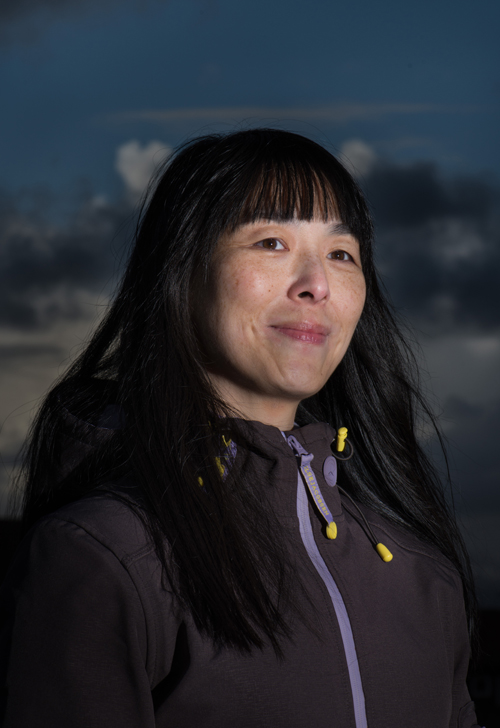
Not Dark Yet, the new novel by Berit Ellingsen, is a magnificently disconcerting work. Its narrative shifts through time and space, with its protagonist living in isolation, then flashing back to explain the disquieting circumstances that led him to make that decision. A host of other elements make their presence knows, from flawed relationships to catastrophic climate change to an astronaut training program. It’s like little else I’ve read, and I conversed with Ellingsen via email to learn more about the process of writing it.
Questions of space and space exploration are raised throughout Not Dark Yet. What first drew you to these subjects?
I’ve always been interested in space science, space exploration, and the life sciences, including ecology. So much so that I work as a science journalist with a specialization in space science and the life sciences. Thus, I follow the news in space science and climate science from a professional as well as a personal interest. It was therefore very natural that these subjects were included in the novel.
There’s a lot happening in this novel: astronaut training programs, environmental distress, and Brandon’s complex relationships. Did one particular element come first?
I knew the novel would end with a certain image, involving difficult interpersonal relationships or perhaps a power struggle of some kind, so they probably came first. Then the context surrounding that, the relationships in more detail, the various groups that have their different desires and plans, as well as the world itself, one that has passed the point of catastrophic climate change, but is at the same time on the brink of being able to explore another planet for the first time.
Your bio mentions that Svalbard is one of the places where you live. Would you say that that’s had any effect on your fiction?
I do not live in Svalbard yet, but spend as much time there as I can. I know I will be going up there for years to come. I do have plans of moving there, to start with staying a whole summer, and then an entire year. But for now I’m just a tourist.
Svalbard and the high Arctic has probably had big impact on my writing, especially in terms of considering the landscape and the natural environment in writing, but it hasn’t appeared directly in my fiction yet, only in a few essays so far.
The high Arctic is one of the few places I have heard people warn others of going to, because once you fall for it, you keep returning. In Norway it’s called polar fever, and people have asked if I have polar fever, and I do. The landscape of the high Arctic is extreme, because it’s barren, and very cold in the winter, but it’s also deeply impressive and stunningly magnificent. The closest I can compare it to are places at very high altitude, far above the tree line, but not even that can give the sense of purity and deep calm that is there. I’ve heard others use the word “magical” and “extraterrestrial” about it, and Svalbard is after all used as a Mars analog to test equipment and procedures that are headed for the red planet. To me, it first and foremost gives a glimpse of a place that for now is uninhabited and still has a lot of wildlife present. But of course, climate change is happening the fastest in the polar regions, and that is highly visible.
Do you do most of your writing in one particular place?
Yes, I’m not one of those writers who can sit in cafes or on trains or planes and write. I can write in different places, but it can’t be moving and should be relatively quiet. One reason for that is probably because I listen to the rhythm of the sentences and words as I write, and consider rhythm to be an important part of writing.
I usually write at home, at my desk, with my cat sleeping next to the laptop. In cafes I tend to be distracted by the people around me, and since I’m terrible about listening in on other people’s conversations, I get busy doing that instead of writing.
Something that I noticed more and more as the novel went on was your reference to continents rather than countries. What prompted you to take this approach?
First and foremost to have the reader, no matter which country or what continent she may reside on, to identify with the places described in the novel. And to dampen the notion that “Oh, that kind of climate change might happen in the places mentioned in the book, but definitely not here”. Basically, to give a sense that catastrophic climate change might happen, no matter where you live, even in the rich countries, or places that have not felt climate change much so far.
When I mentioned the title of your novel to a friend, he asked if it was taken from the Bob Dylan song of the same name. If so–what drew you to that as a match for this?
Other interviewers have asked about this as well. I wasn’t aware of Bob Dylan’s song before someone mentioned it to me recently. I was inspired by the haiku poem “Not Quite Dark Yet” by the Japanese poet Yosa Buson (1716-1784), who is one of the most well known of the classical haiku poets. Buson’s haiku has little to do with climate change, or even the falling of the day, but of losing or letting go of everything, especially one’s sense of ownership and control, which is a theme common in classical haiku.
Photo: Alexander Chesham
Follow Vol. 1 Brooklyn on Twitter, Facebook, Google +, our Tumblr, and sign up for our mailing list.
